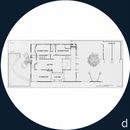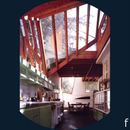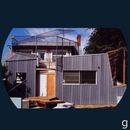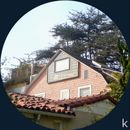











Before Frank Gehry acquired international prestige as the architect of the Guggenheim Museum in Bilbao, he designed his own house in Santa Monica (1977 - 78). The story starts when his wife, Berta, bought a small pink bungalow in a bourgeois neighbourhood. Gehry decided to redesign what he considered "a dumb little house with charm", to build around it and try "to make it more important". The result was so emotive among their neighbours that the new house was even shot at one night!
The neighbours' prejudice
The architect wanted to make the little pink bungalow look more important than it was by following the guidelines of Marcel Duchamp. His work had changed people's attitude towards ordinary and everyday things when displaying them as works of art. Gehry made an extension to the ground floor which wrapped the little house on three sides. The old house appeared, in that way, as a familiar object within the new house. The exterior of the original house was left almost untouched, even when parts of it were inside the new house. Its interior was remodelled considerably. In some places, it was stripped to lath and framing. In other places, it was repaired or retained. When entering the house, the distinction between the new and the old was emphasised as one had to pass through two doors - one designed by Gehry followed by the original door to the bungalow.
"I was trying to build a lot of ideas," recognised Gehry when explaining his project. In those days, in the years when he was short of money, he was fascinated with cheap materials like chain link fencing, plywood and galvanised corrugated iron. Enclothing the old house seemed a good opportunity to experiment with the mass produced materials that were not ordinarily used in the building of houses.
It was then when the neighbours approached him to say "We don't like your house" - to which he replied, "What about the boat that you have in the backyard … or the van? This is all the same, the same aesthetics." But they said "No, no, that is very normal." Twenty-five years later Gehry is still fascinated by such contradiction: "Everybody hates the chain-link fence but nobody sees it. What they see is a tennis court and a tennis court is a symbol of wealth."
The evolution of the family
One night when Arthur Drexler, then the director of the Department of Architecture at The Museum of Modern Art in New York, was invited to dinner at Gehry´s house, he asked questions about whether the pealed paint on the walls was intentional or not. At the end of the evening, Berta confessed to her husband that the guest had "thought the house was a joke". At that moment Gehry knew that his research had been successful.
The aspect of the house, with blurred edges between old and new finishes, gives the appearance of being a continuous building process. "We are in a culture made up of fast food and advertising and throw-away and running for airplanes and catching cabs - frenetic. So, I think that those possibilities are more expressive of our culture than something finished."
When Berta and Gehry made the house, they had only one child. Later they had a second one. The children grew and they too soon needed their rooms be refurbished. There have been many later additions, like the small swimming pool that Gehry had started dreaming of or the conversion of the garage into a guesthouse for two daughters from his previous marriage who often visited.
With these recent renovations "I lost the old house!", Gehry acknowledges, when referring not to the bungalow but what had been the revamped house in 1978. His house, which is in continuous transformation, tries to catch up with the rapid evolution of a family.
Photos: Frank O. Gehry & Associates.
Captions for illustrations
a. Frank Gehry (b. 1929) architect.
b. Berta bought "a dumb little house with charm".
c. Model of a possible evolution of the backyard.
d. First floor (1978). 1-Living Area. 2-Dinning. 3- Kitchen. 4- Bedroom. 5-Garage.
e. Second floor (1978). 4-Bedroom. 6-Closet. 7-Master Bedroom. 8-Out Deck.
f. Kitchen window.
g+h. View of the entrance (1978): the aspect of the house gives the appearance of being a constant building process.
i. With the extension carried out in 1993, many considered that the house had lost part of its original raw character.
j+k+l. NEW IMAGES OF FRANK GEHRY'S HOUSE (Dec 06).


